A minor health panic screwed up the week’s operational plans around here, taking Friday List Items off the table for another week. Still, some damn-fine adventures in the Home HandyBastard’s world of tool slut sales and grand designs for the future…
Radio Det. Case of the RTFM
I may have mentioned to you that the Radio Detective is a super-slut when comes to antique-ish ham radio gear made by the late Hallicrafters Company? The two-bit lowdown on this outfit (from Wikipedia) is that it was founded in the Depression era:
William J. Halligan (1898–1992), founded Hallicrafters Company in Chicago in late 1932. Prior to this, he had been involved in radio parts sales for some years but decided the time was right for a handcrafted amateur radio receiver – the company name being a combination of Halli(gan) and (hand)crafters.
The Radio Detective himself cut his teeth (or was it ears?) on an old Hallicrafters S-20R which was in the 1939 genre. A favored uncle – who hasn’t been heard from in eons – worked at a Seattle electronics parts house in the 1950s and 60s. From him, a small aluminum chassis and a single transistor plus a local oscillator adjustable coil (*to loosely couple to the 455 KHz intermediate frequency strip of the radio) managed to earn me QSL contacts from now non-existent places. Rhodesia, Laos, and others were commonplace.
The parts were turned into a “Q-Multiplier” in short-order. Tossing in a 9-Volt battery, headphones turned up more than they should have been, the radio was placed in the middle of the 80-meter novice Morse code band (3.715 MHz said an ancient Peterson crystal plugged into the Eico 723 transmitter) and the controls were slowly advanced.
Just before the experiment ran into the ditch, there was a slight change – almost like a ringing of the background static. All of a sudden…
“YEOWMYGODWHATTHEHELL is that screaming???”
Ah. The joys of Q-Multiplier adjustments. But that was the only “bad news”. Operationally, that radio could pull signals from the Oort Cloud, given a chance. Sadly, the radio plain sucked above the 15 MHz WWV time standard, but below that? Smokin!
This led to a life-long fascination with Halligan’s children. My modest collection (in various states of restoration) include:
- SX-101 (MK2 version, I seem to remember), with the matching HT-32 transmitter. And the HT-33 linear amplifier.
- The next matched rigs are the SX-111 receiver and the HT-37 transmitter.
- While the top of the line is the SX-117 (a triple-conversion super radio), the barely worthy HT-44 transmitter and the coveted Loudenboomer HT-45 linear.
- There are other odds and ends: SR-150 (five band transceiver), SR-160 an only moderately used (wide as a barn door) tribander for 80, 40, and 20 meters.
- And a busted FTM-300 (or some-such) from the post-Halligan period when Northrop, which has bought out the Halligan family, itself bit the financial dust.
I don’t ever spend this much time on foreplay, unless there is a good radio story…which fortunately, there is.
The Late Model Twins
On the way out to the final smoke and cement wall of corporate America, the transitioning Hallicrafters company came out with a very much undiscovered pair of gems. The HT-46 single sideband transmitter was nothing too special. Not a lot of power, but a small footprint made up for it.
On the other hand, the single conversion SX-146 was a great little radio. No, it will in no way compete with the high-end Rice Boxes (like the Icom 7851 with a huge high-resolution display on the front panel with computer, well, everything only a button press (or swipe) away.
But, with input from the late Lew McCoy (who was like the one-man band promoting single sideband with 9 MHz architectures in the 1950s, made possible with the loads of leftover WW 2 gear (the old Command Sets (ARC-5’s) and so on) the radio played well. Very, very well.
We will skip the front panel (I have asked the Twins to pose when they come out of treatment) and jump right to the problem the receiver was having. It didn’t work. Loose wires in the power supply area.
This is what confronted me when I opened up the radio.
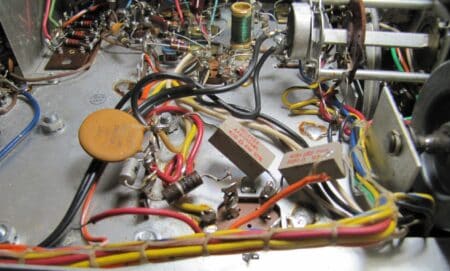
Now let’s learn some serious radio shit, OK?
- Center foreground you can see a brown round thing. That’s an electrolytic capacitor. Whoever worked on this radio before I bought it had grown frustrated as hell, because the radio was not working. There are three tabs sticking up from the capacitor. And everything ohmed out like it should. I put it together again, using the cheapo component meter to confirm values because these caps do dry out over time.
- Tuning the radio on, it fired right up with some noise, but nothing was coming from the antenna. “My, that’s not good.” The Radio Detective’s trained ears told him the radio had high voltage, a tiny bit of hum, and the tubes were at least trying to work. So WTF, right?
It’s here that old farts in ham radio (like me) and Hank and Wm of the Radio Ranch have a tremendous leg up on kids just entering the pro leagues of real electronical trouble-shootizing.
We know, for example that:
- The SX-146 would “transceive” with the HT-44 transmitter. It would take an additional cable, though.
- We also know that few people have an innate understanding in the software madness of modern times to hark back to the Early Days when there were no menus and we did physical things with radios to make them work. Slide switches. It was Miraculous, trust me.
Since Ure’s library of Hallicrafters had the manual, a quick inspection of the schematic diagram told me all I needed by inspecting just a few likely trouble spots:
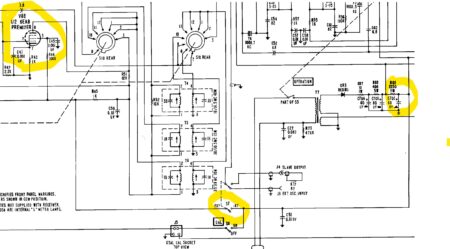
There are three – and looking at them left-to right will explain how this mystery was solved. Attention to the yellow circles
- Upper Left: This is V8B, 1/2 of a 6EA8 Premixer. Which we assume is before (pre) the Mixer tube.
- Detecting to the middle (center) we see there is a switch that goes over to the (all disconnected when found dead) area of the power supply.
- Where, zoom and swoon here, it connects to the well-filtered side of high voltage.
Follow along here. DC power (which we have, per the hissing) goes through a switch, and then hits the screen grid which powers up the premixer. Which all begins to pencil out. As in “Logically, Captain, no one would want two local oscillators (one in the receiver and the other in the transmitter) duking it out for control.”
Tell me more about this switch.
Oh, here it is, where the manual says it should be!
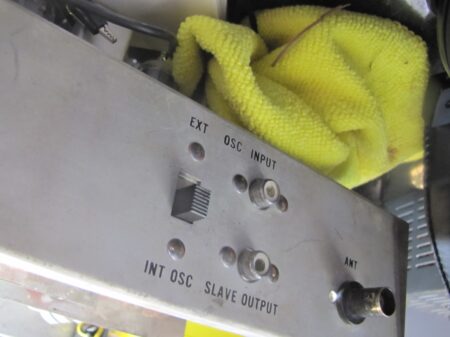
Case Solution
When found, the switch had been in the External Oscillator position. And, since only a handful of the HT-44 transmitters were ever sold, the odds are near 100 percent that this is a hamfest (swap meet) bastard child, left in a basket on the last day of the meet-up.
Flip switch. Now it works.
Case closed!
And thus, the case title: RTFM – read the frickin manual!
(Well, except for the $40 worth of tubes because a number of the existing ones become 25-foot pistol range targets. Though, in all honesty, my son (KF7OCD) is known to say “Dad, you couldn’t hit the side of a pair of 4-1000’s, side-by-side, in the dark at 10-feet – even with the filaments on.”
He’s more polite at fires and medical emergencies, I hope. Such are the burdens of Radio Detecting.
A further Radio Detective Note:
From reader D’lynne: America’s Last Morse-Code Station. Go grab the site info at this dandy site after you’re done here. Maritime Radio Historical Society (radiomarine.org)
Pallet Shed Dreams
Yes, with a larger than expected tax refund coming, we could buy a large generator house (12X18 unfinished type deal) and have it installed where we want. But we like “ready funds” and enjoy the challenge of minimalism.
The design is “How close to zero for a great generator shed, to get this sucker out of the shop?”
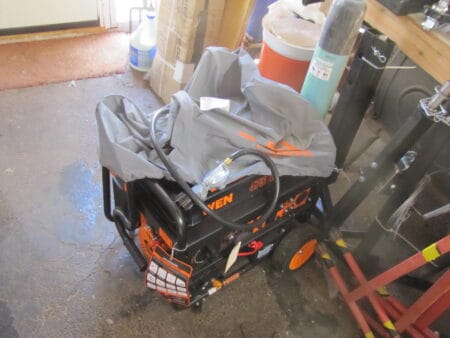
Now, meet the solar panel pallet that arrived last week. This will become the “floor system” (with a sheet of OSB cut down on top).
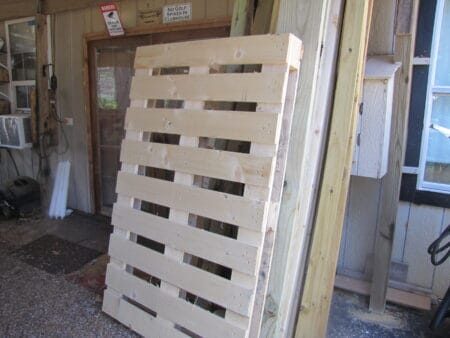
42 inches by 67 inches long. Call it 3-1/2 by 5-1/2 feet, should be plenty of room
On top of this will go assorted studs to hang cheap siding on, and two cheapo windows (singe glass, plastic from Amazon like these). And on Craigslist, a $100 grungy (but salvageable) exterior door was found.
All in?
- Piers and pallet $0
- Two windows $120
- Door $100
- Misc. hardware: $60.
So, looking at it, can I get something better (and stronger) than this for $280? Likely not. Another hundred and cheap siding….yeah, better than seeing real money leave.
Besides that, where’s the sport in writing checks?
Time to go bang something,
George@Ure.net (ac7x)

This one is for LOOB… “Cardboard Box Engineering”
https://sciplus.com/cardboard-engineering-book/
“Dad, you couldn’t hit the side of a pair of 4-1000’s, side-by-side, in the dark at 10-feet – even with the filaments on.”
ROFL! My 5kw AM radio transmitter used a pair of 4-1000s to AM plate modulate the final PA tube. A screened peep-hole let one see just how cherry red the finned plates of the tubes were running. Along came the days of the ‘super-modulated audio processors’ for rock & roll radio and I soon found I was melting holes in those red hot finned plates! Tube life was about halved. Before I moved to Hawaii and had to leave trailer loads of my ‘junk’ behind, I had one of those 4-1000 globes with the melted plates on my shelf in the living room.
That pallet looks brand new, like it’s never been shipped. My generator sits in the corner of the shed and only comes out annually for the checkup run. Pigtail cables ready to attach to the dedicated breaker for it in the distribution panel outside. I had thought about making a little generator shed for it outside, but it’s too close and visible from the road for inviting marauders. Haven’t needed it yet, but just the year before I bought the Volcano Ranch here there was a hurricane that took the power out in this area for many weeks. So I’m prepared.
Portable solar panels are very expensive compared to glass panels, and have limited lifespan. They do have the advantage of being available for unforeseen road trips, and staying out of sight until they are needed.
I ran into this sale:
https://iallpowers.com/products/allpowers-400w-portable-solar-panel
That’s the lowest price I have seen on a 400 W folding solar panel. A couple of those would take care of basic emergency contingency needs until I move forward with a fixed installation.
Get a four pack of these https://amzn.to/3UXb6sM for $219. Make up some precut mc4 solar connectors and pocket $200 savings. But then I’m all about cost/performance….
It looks like the way to dodge the onerous code restrictions on DC solar circuit entries is going to be to install a dedicated solar equipment building, put the batteries and inverter in it, then run a 120 VAC UPS circuit into the house. I’m looking at shed options. I have built sheds in the past but I am going to start by looking at a prefab. I could get by with a relatively small building, but I will probably start by looking at a 8′ x 12′ so I don’t get it too crowded.
I have a couple 120 w panels similar to the ones you mentioned. They are heavy, and trying to prop them up turns in to a major project unto itself.
(“RTFM – read the frickin manual!”)
Ever notice.. the manuals are written in about forty different languages.. then you get the english one.. ( this is for the women ) then the pictures.. ( this is for the Men.) see an american man was born with the ability to instantly know and understand all things technical.. but if you do have a question theres the picture LOL LOL
Nice work on the Hallicrafters. Love boat anchors.
Coming back from seeing the grandkids I noticed a big hand painted sign at a place selling rock, dirt and firewood. It said shipping containers for sale or rent. Had to stop but Diana was less than enthusiastic. Found a decent looking 20’er that said in giant red letters CHINA on one side. While negotiating I noticed lying by the side of a pile of firewood a fairly clean looking paint locker about the size of Nancy Pelosi’s refrigerator. Ended up with both. Heading up to pick both up after church today. The container idea was orignally for POL storage but with Nancy’s fridge it is now on the project list for materials storage.
Roll up is thus:
20′ container – $1700
Nancy’s refrigerator- $0
(This includes cool looking Penzoil, Lucasoil, and STP graphics)
6 pack of Schlitz beer – $12
For afterward when neighbor Ed brings big green Bertha over to pick all this up off my trailer and set it in place.
2 days and 2 nights at Big Cedar Lodge (mid week) – Scared to look but Diana is excited. One last big one before the balloon goes up. Note to self to ask CPA if this could be a business expense.
Stay safe. 73
Yes, if you store farm goods only in it (tillers, feed, fertilizer, sprays, etc) and enter on your Sched F I believe (I did goose eggs on my F this year, $984 profit last year. Rules are more relaxed for us tree growers.
And if sec. 179 is still around next year expense the whole thing in yr 1
That’s the plan for 24. Unless we go into the bamboo business, Ha!, I will honor my promise to my Queen and fully retire next year. She may change her mind with both of us home together all day every day though. Hubba Hubba. Doubt I’ll be able to not have something to do though. I have a meeting at my financial advisor’s office the week after next to pick up taxes and set the timeline for the shutdown next December. He does not see much of anything good after this year for old farts er ranchers like me. The ranch may even go on the block if we can find something suitable elsewhere.